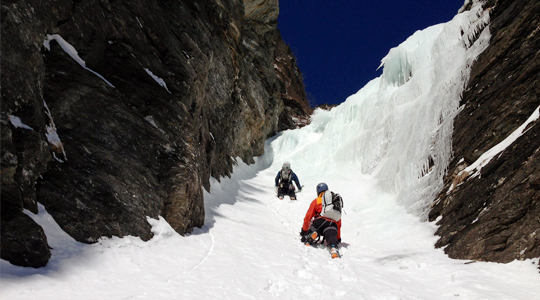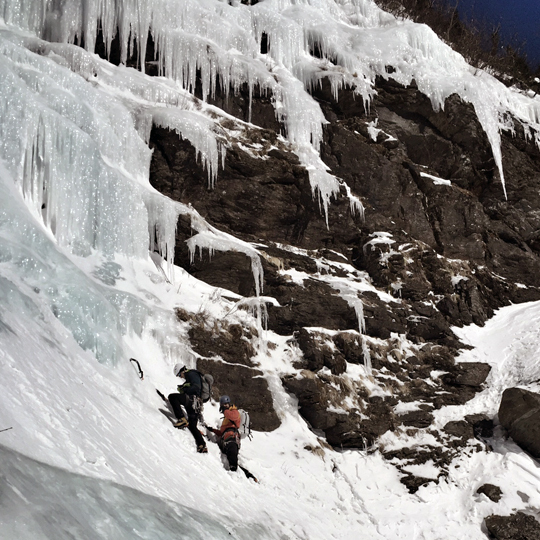“Spring” conditions on Mt. Washington… -20C and 30mph winds [Photo] Eddie Schoen
MSRP: $70
I never gave too much thought to my socks. In general, any pair of mid-weight wool socks would have been interchangeable for most days out in the mountains of New England. The past couple of winters have been exceptionally cold, though. Even with the toe warmers, there have been several days this winter when I ended up with painfully frozen toes.
In New England, where we have an odd combination of maritime, continental and arctic climates, a pair of higher-altitude boots would not feel out of place even at our relatively low elevations. A standard pair of insulated leather mountain boots, like the Nepal Evos I generally use, is usually sufficient. For those of us who tend to suffer from cold toes, the options seem fairly clear: Either spend $800 or more on a pair of lightweight double or super-gaiter boots, or be a little uncomfortable from time to time. Or, there is another option: warmer socks. However, there is only so much room in the boots, and a thicker sock always seems to leave my feet feeling even colder, most likely because of the reduced circulation. As such I had basically written socks off. So when I got asked to review some super-techy, prestige-priced expedition socks, I didn’t think much of it. A $70 pair of socks? Seemed gimmicky.

[Photo] Leighton Johnson
After using the Lorpen TEPAPA (Trekking & Expedition Polartec and Primaloft) socks, I have to say they’re quite impressive. The construction is like no sock I have ever seen. The amount of seams and panels used to build this sock was at first a little offputting. It looks too complicated for a mere sock. Sometimes, though, sophistication proves to be the answer. The TEPAPs have more in common with a pair of handcrafted leather shoes than your average athletic tube sock. Flip them inside out, and you can see that the fabric is cut and sewn into precisely articulated panels. Yet, behind the craftsmanship, the idea is quite simple: the body of the sock is made with Polartec fleece, the same warm, breathable material many of us love in our midlayer pieces. Layered atop this, in key areas needing a little extra warmth (i.e., underfoot and capping around the toes), is an additional panel utilizing Primaloft insulation. The beauty of this is that you get an incredible warmth-to-weight ratio, especially for a sock.
I was initially convinced that I would feel the seams rubbing and chafing, but once on your foot you don’t notice the stitching at all. The TEPAPs use the same type of flatlock seam common on most technical fleece layers, which tends to work well in terms of both comfort and durability. They fit like a pair of fleece gloves for your feet. Which brings me to the next point: how they feel next to skin. The socks are soft, cozy and breathe quite well. The cuff comes up to just below the knee and stays put all day, even after pulling layers on over the top. Though the sock certainly feels well cushioned, it is by no means bulky. In fact, it is noticeably thinner than most of the thicker performance wool socks I have tried (yet warmer–see below). When you first slip it on, the extra layers underfoot do feel a bit odd, like wearing a sock under a sock, but once in a boot this effect is hardly noticeable. My one worry is that the socks feel a little too slick on the skin, but even as someone who is prone to heel blisters, I have not experienced any issues. It seems like the additional panel on the heel does a good job of reducing friction.
So, how do they perform? Well, in one word. . .warm! On a typical day ice climbing in Smugglers’ Notch, with air temps hovering just below double digits, my feet were beginning to feel a little swampy on the hike back down to the car. That day in particular we were on more of a speed mission and climbed a thousand feet or so of steep snow and moderate ice. Staying warm would not have been a problem, but my feet are usually the first to get cold, and they were nearly overheating.

[Photo] Chris Van Leuven
A more demanding test was wearing the TEPAPs on a four-day avalanche-training course on Mt. Washington. This was a bit more in line with what these socks were designed for: we skinned up 4,000-5,000 feet, then stood around to study snow crystals for a couple hours in -20 C temps and 30 mph winds before riding back down. The results were definitely positive. My feet were about as cozy as could be, to the extent that I didn’t have to think much about them. Laying the socks out in my sleeping bag overnight left them dry the next morning. And another night, even when I forgot to stuff them into my bag, the TEPAPs were mostly dry after hanging out in the cold van all night. They are synthetic and they go on your feet, so of course after a few days of extended wear they get a little stinky, but no worse than other synthetic socks. After the week on Mt. Washington, I had no blisters, trench foot or frostbite.
So, yes, the TEPAPs passed the test.
Pros:
Super-warm
Lots of padding/cushioning with minimal bulk
Calf band keeps sock up high, does not slide down like other socks
If looking at a warmer pair of ice boots, these could be a much cheaper option
Anatomical cut works well (if it fits)
Cons:
Material is slick, especially when damp. Could contribute to blistering.
Lots of stitching due to anatomical design (lots of panels/pieces); complex design
Tend to get a little stinky.